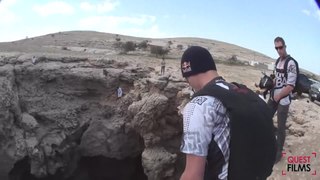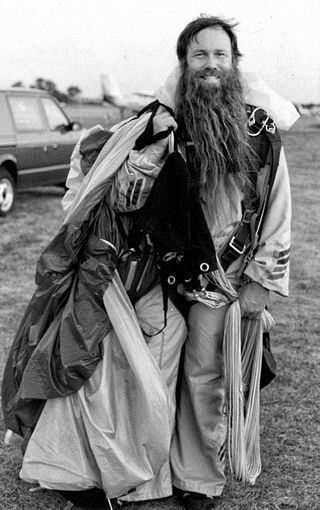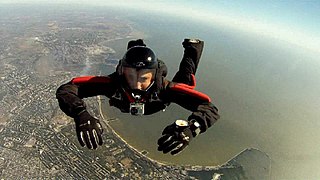Related Research Articles

BASE jumping is the recreational sport of jumping from fixed objects, using a parachute to descend safely to the ground. "BASE" is an acronym that stands for four categories of fixed objects from which one can jump: buildings, antennas, spans (bridges), and earth (cliffs). Participants exit from a fixed object such as a cliff, and after an optional freefall delay, deploy a parachute to slow their descent and land. A popular form of BASE jumping is wingsuit BASE jumping.

A parachute is a device used to slow the motion of an object through an atmosphere by creating drag or, in a ram-air parachute, aerodynamic lift. A major application is to support people, for recreation or as a safety device for aviators, who can exit from an aircraft at height and descend safely to earth.

Wingsuit flying is the sport of skydiving using a webbing-sleeved jumpsuit called a wingsuit to add webbed area to the diver's body and generate increased lift, which allows extended air time by gliding flight rather than just free falling. The modern wingsuit, first developed in the late 1990s, uses a pair of fabric membranes stretched flat between the arms and flanks/thighs to imitate an airfoil, and often also between the legs to function as a tail and allow some aerial steering.

A drogue parachute is a parachute designed for deployment from a rapidly-moving object. It can be used for various purposes, such as to decrease speed, to provide control and stability, or as a pilot parachute to deploy a larger parachute. Vehicles that have used drogue parachutes include multi-stage parachutes, aircraft, and spacecraft recovery systems.
Tracking is a technique used by skydivers during freefall to increase their horizontal speed. Tracking is considered a fundamental skill in the sport because it allows multiple skydivers to gain separation from each other prior to deploying their parachutes. Nearly all licensing organizations mandate a student show proficiency at tracking in order to obtain their skydiving license.

CYPRES is an acronym for Cybernetic Parachute Release System. It refers to a specific make and model of an automatic activation device (AAD), a device that automatically activates a parachute under certain circumstances. A CYPRES is designed to activate the reserve parachute at a preset altitude if the rate of descent is over a certain threshold. The manufacturer of the CYPRES is Airtec.

Bill Booth is an American engineer, inventor, and entrepreneur in the skydiving equipment manufacturing industry. His invention of the 3-ring release safety device has enhanced skydiving safety. He founded the companies United Parachute Technologies and Complete Parachute Solutions, which had 150 employees as of 2015.

In skydiving, an automatic activation device (AAD) is a dead man's switch consisting of an electronic-pyrotechnic or mechanical device that automatically opens the main or reserve parachute container at a preset altitude or after a preset time.

A malfunction is a partial or total failure of a parachuting device to operate as intended. Malfunctions may require a skydiver to cut away their main parachute and deploy the reserve parachute.

A pilot chute is a small auxiliary parachute used to deploy the main or reserve parachute. The pilot chute is connected by a bridle to the deployment bag containing the parachute. Pilot chutes are a critical component of all modern skydiving and BASE jumping gear. Pilot chutes are also used as a component of spacecraft such as NASA's Orion.

Tandem skydiving or tandem parachuting refers to a type of skydiving where a student skydiver is connected to an instructor via a harness. The instructor guides the student through the whole jump from exit through freefall, piloting the canopy, and landing. The student needs only minimal instruction before making a tandem jump with the instructor. In the United States most skydiving centers and clubs require that you be 18 years or older to skydive whereas in other countries the minimum age can be lower or higher. This is one of three commonly used training methods for beginning skydivers; the others being Static line, Instructor-assisted deployment (IAD), and Accelerated freefall (AFF) (k).

A reserve static line, occasionally called a Stevens Lanyard, is a device that automatically opens the reserve parachute container when the main parachute is cut-away. The RSL is a lanyard connecting one or both of the main parachute risers to the reserve ripcord.

A vertical wind tunnel (VWT) is a wind tunnel that moves air up in a vertical column. Unlike standard wind tunnels, which have test sections that are oriented horizontally, as experienced in level flight, a vertical orientation enables gravity to be countered by drag instead of lift, as experienced in an aircraft spin or by a skydiver at terminal velocity.

Banzai skydiving is a rumored form of skydiving in which the skydiver throws their parachute out the airplane door, waits, and then jumps after it. To be successful, the skydiver must catch the parachute, secure it, and glide to the projected landing zone. There is no known, credible evidence that a banzai skydive has ever really occurred according to its definition.

Parachuting, including also skydiving, is a method of transiting from a high point in the atmosphere to the surface of Earth with the aid of gravity, involving the control of speed during the descent using a parachute or parachutes.
A ripcord is a part of a skydiving harness-container system; a handle attached to a steel cable ending in a closing pin. The pin keeps the container closed and keeps the spring-loaded pilot chute inside. When the ripcord is pulled, the container is opened and the pilot chute is released, opening the parachute. On tandem systems the ripcord releases the 3-ring release system anchoring the bridle to the harness-container, allowing the parachute to open.
Lewis B. Sanborn is an early developer of the freefall method of skydiving who along with Jacques-André Istel helped popularize sport parachuting in the United States. He is considered by many to be a pioneer and legend in the sport. In 1959, Sanborn and Istel co-founded Parachutes Incorporated, the first commercial parachuting center in the United States. An accomplished pilot, member of the United States Army’s 82nd Airborne Division from 1948 to 1952, national skydiving champion in 1954 and 1959 and hall of fame skydiver He continues to jump on a regular basis and is still very active in the skydiving community.
Firebird USA LLC is an American parachute manufacturer based in Eloy, Arizona. The company also has locations in Germany, Sri Lanka, and the Czech Republic, and was formerly based in Füssen and Bitburg, Germany. The company specializes in the design and manufacture of parachutes and at one time also constructed paragliders and parafoil kites.
Luke Aikins is an American professional skydiver, BASE jumper, pilot, and aerial photographer. He is the first person to intentionally dive from mid-tropospheric altitude and land safely without a parachute or a wingsuit and the second skydiver to intentionally jump and safely land without using a parachute.
A Main-Assisted Reserve Deployment (MARD) system is a skydiving safety device for parachute systems. While there are many variations, the operation and intended outcome for each is the same: open the reserve parachute container and extract the reserve parachute's deployment bag using the jettisoned main canopy. A MARD builds upon how a reserve static line (RSL) safety device works and in most circumstances, MARDs incorporate an RSL.
References
- ↑ "Stainless Steel Curved Closing Pin". chutingstar.com. Retrieved 2014-02-28.
- 1 2 "HowStuffWorks "The Drogue Chute and Parachute Deployment Sequence"". adventure.howstuffworks.com. Retrieved 2014-02-28.
- ↑ "U.S. Parachute Association > About Skydiving > Skydiving Terminology". uspa.org. Retrieved 2014-02-28.
- ↑ "Pin Out on Exit | Parachutist Online". parachutistonline.com. Archived from the original on 2014-02-22. Retrieved 2014-02-28.
- ↑ "Skydiver Closing Pin Necklace". chutingstar.com. Archived from the original on 2014-02-22. Retrieved 2014-02-28.